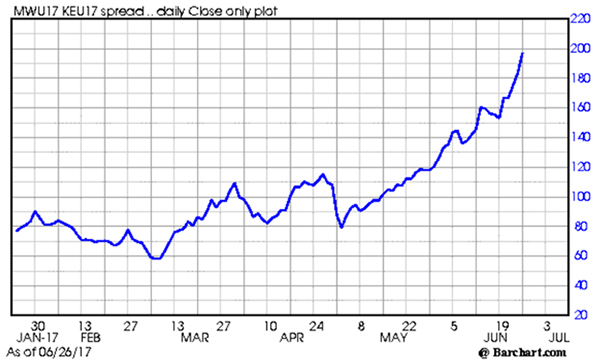Forty-one percent of winter wheat has been harvested in the 18 reporting states, well ahead of the 39 percent average. The Kansas crop is close to its 47 percent average, while Nebraska has harvested only 1 percent of its wheat compared with an average 8 percent. The condition of the Kansas crop is unchanged at 46 percent good/excellent and 23 percent poor/very poor.
The big concern is the spring wheat crop. Twenty-eight percent of the acres in the six states is rated poor/very poor and only 40 percent good/excellent. This compares with 5 percent and 72 percent last year. South Dakota is a large part of the reason: 62 percent is in the bottom categories and 12 percent in the top. At the same time, the Canadian crop will be down because of a major shift to alternative crops.
The futures markets are reflecting the difference in expected availability: The premium for September hard red spring wheat over hard red winter wheat has climbed from 60 cents in March and 80 cents at the start of May to close to $2/bu. Spring wheat open interest has jumped by 300 to 500 percent as traders bet high-protein supplies will be tight.
Spread for Minneapolis futures/Kansas City futures, September 2017 contract

Corn/soybeans
Corn silking is reported at 4 percent, one point behind average as of June 25, according to USDA.
The 18-states rating is unchanged. Iowa improved one point on the top side since last week. Nebraska’s crop condition lost four points on the top end and gained two on the bottom end of the ratings. South Dakota corn also deteriorated by several points at both ends.
| States |
Corn (percent) |
Soybeans (percent) |
|
Poor/very poor |
Good/Excellent |
Poor/very poor |
Good/Excellent |
| Iowa |
4 |
79 |
5 |
74 |
| Kansas |
7 |
69 |
2 |
67 |
| Nebraska |
6 |
74 |
7 |
70 |
| South Dakota |
20 |
46 |
21 |
39 |
| 18 States |
8 |
67 |
7 |
66 |
Soybean emergence, at 94 percent, is actually ahead of its 91 percent average. Blooming, at 9 percent is 2 points ahead of average. Iowa was virtually unchanged, with just a point added to its poor/very poor rating, while the Kansas crop saw improvement at both ends. As with corn, Nebraska saw a few points trimmed from its rating at both ends. South Dakota’s bean crop tumbled from 47 percent to just 39 percent good/excellent and its poor/very poor jumped from 16 to 21 percent.
Grain sorghum
Planting stands at 95 percent, a few points ahead of the 93 percent average in the 11 reported states. However, heading is 2 points behind the 22 percent average. Condition, at 65 percent good/excellent and 4 percent poor/very poor is a bit behind last week’s 66 percent though the rating improved by one point at the low end of the range.
Pasture/Range
Pasture condition slipped from 63 percent good/excellent to 60 percent – one point behind last year. More than half the acres in the Dakotas are ranted poor/very poor, compared with 8 percent in Iowa and Nebraska and only 2 percent in Kansas.

